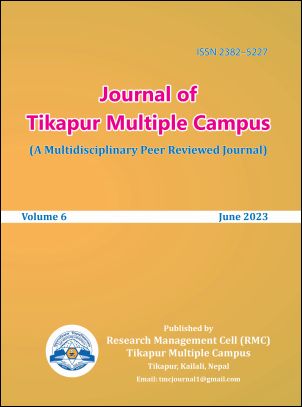Response of Nutrient Omission on the Performance of Rapeseed at Parwanipur, Bara, Nepal
DOI:
https://doi.org/10.3126/jotmc.v6i01.56388Keywords:
productivity, nutrient omission, genotypesAbstract
The field experiment was conducted to study the effect of nutrient on growth, yield and yield attributes of promising rapeseed genotypes, and assess the economics of nutrient management in Strip Plot Designat the station of Directorate of Agricultural Research, Parwanipur, Bara during winter season of 2019with two rapeseed genotypes (Morang Tori 2 and ACC 9109) in horizontal stripe and six combination of nutrient doses of NPKS (60:40:20:20 kg NPKS/ ha (N1), 0:40:20:20 kg NPKS/ ha (N2), 60:0:20:20 kg NPKS/ha (N3), 60:40:0:20 kg NPKS/ ha (N4), 60:40:20:0 kg NPKS/ ha (N5) and 0:0:0:0 kg NPKS/ ha. (N0) in vertical strip with three replications. The results revealed that at N1 treated plot the plant height at 30 DAS (64.53 cm), 60 DAS (84.22 cm), 90 DAS (104.62 cm, no. of primary (8.50) and secondary (41.50) branches, siliquae/plant (138.15), seed/siliqua (15.33), test weight of seed (3.45 gm), yield (1072.5 Kg/ha.), B: C ratio (1.94) were higher as compared to control treatment or N0. The interaction of ACC 9109 and 60:40:20:20 Kg NPKS/ha gives highest yield (1343 Kg/ha) with highest B: C ratio of 2.442 and interaction of ACC 9109 and control plot (315 Kg/ha) gives lowest yield with B: C ratio of 0.882. It was concluded that the cultivation of ACC 9109 with 60:40:20:20 Kg NPKS/ha can improve crop growth, grain yield and profitability of rapeseed in Parwanipur, Bara, Nepal.
Downloads
Downloads
Published
How to Cite
Issue
Section
License

This work is licensed under a Creative Commons Attribution-NonCommercial 4.0 International License.
This license enables reusers to distribute, remix, adapt, and build upon the material in any medium or format, so long as attribution is given to the creator. The license allows for commercial use.




